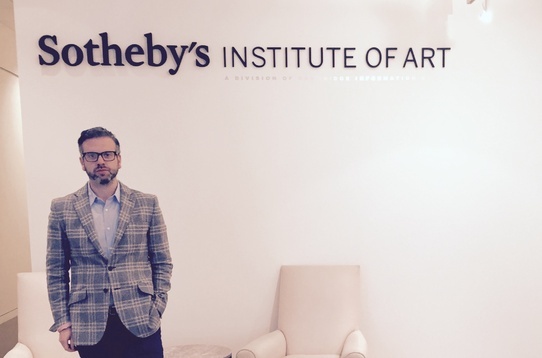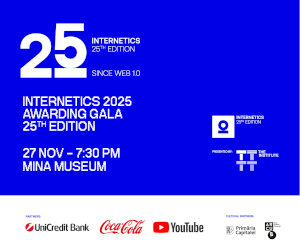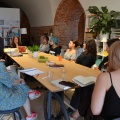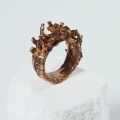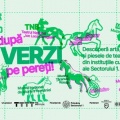Jonathan Friedlander is 100% american, but in the same time he is a new yorker. He was born in New York and grew up in the suburbs. He is old enough to remember New York when it was dangerous and seedy and before everyone took vacations to Turkey and Colombia and was friends with an Australian who lives in Brooklyn.
How did you know you wanted to be part of the Art world when you were a student, where did it all start?
When I was a student I didn’t know what the art world was. I was actually a creative writing major in college taking sporadic art history courses if they fit into my schedule. Then I took a course that surveyed 19th and 20th century American and European art. I was transfixed. It’s the story of art that intoxicated me, or to be more accurate, the stories that art tells. It’s like watching history unfold except instead of politics, science and war it’s a history of the human condition (as effected by politics, science and war). And when you strip away the (often exaggerated) elitism there’s the truth that to understand art (in all it’s forms) is to understand ideas, systems, emotions and human aspiration. Then, even all that can disappear and you see that art can be about art, about making, observing, shaping and writing and that’s a whole new satisfaction level because you see just how much can be incorporated into those seemingly small and arcane acts. It becomes nothing short of it’s own language. For all of it’s inconsistencies art is a logical system to me; fair, all-encompassing, brutally human and often quite funny. It also tells the history of the world, purposefully and by accident. In that way art, and thereby the art world, made sense to me, I understood why art existed at a time in my life when the rest of the world was overwhelming and confusing to me. I knew it wouldn’t be without its struggles, but I gravitated toward art as a career because I wanted to be surrounded by those sensibilities and work within a language I was beginning to understand.
Tell us about Sotheby's Institute of Art. Who should apply, at what stage of their career?
I’m hardly agnostic on the matter and I don’t want to be such a biased source so I’ll just state some facts. SIA’s locations are in the best art cities in the world, New York, London, Los Angeles, Beijing and well, Online (a nation in a way). Sotheby’s Institute is for people who want to know the art world. We do have art history courses and they’re amazing, but a degree or a short course from SIA introduces the world of art where business comes into play. Galleries, auction houses, art fairs and valuation – the very subjects that art history programs eschew is exactly what SIA embraces. I’m proud to market it. I get to see networks built and careers started and I know the people who run it and they’re good people who don’t just understand art, they understand education and careers and the real value that education can provide. I’m envious of the MA students who come and what they get to learn. It took me a long time to piece together what they learn in 15 months.
Jonathan Friedlander has been the director of an art gallery in New York, and he is now the Vice President Marketing of Sotheby’s Institute of Art. Mara Dănilă asked him for a few advices for young Romanian artists in an interview for THE Institute.
How did you know you wanted to be part of the Art world when you were a student, where did it all start?
When I was a student I didn’t know what the art world was. I was actually a creative writing major in college taking sporadic art history courses if they fit into my schedule. Then I took a course that surveyed 19th and 20th century American and European art. I was transfixed. It’s the story of art that intoxicated me, or to be more accurate, the stories that art tells. It’s like watching history unfold except instead of politics, science and war it’s a history of the human condition (as effected by politics, science and war). And when you strip away the (often exaggerated) elitism there’s the truth that to understand art (in all it’s forms) is to understand ideas, systems, emotions and human aspiration. Then, even all that can disappear and you see that art can be about art, about making, observing, shaping and writing and that’s a whole new satisfaction level because you see just how much can be incorporated into those seemingly small and arcane acts. It becomes nothing short of it’s own language. For all of it’s inconsistencies art is a logical system to me; fair, all-encompassing, brutally human and often quite funny. It also tells the history of the world, purposefully and by accident. In that way art, and thereby the art world, made sense to me, I understood why art existed at a time in my life when the rest of the world was overwhelming and confusing to me. I knew it wouldn’t be without its struggles, but I gravitated toward art as a career because I wanted to be surrounded by those sensibilities and work within a language I was beginning to understand.
How was life working for an art gallery in New York?
It’s not easy but it can be extremely rewarding. I worked in one of the few dedicated photography galleries in New York City. The best result of that experience was the knowledge I gained about photography; the capabilities of this medium, it’s history, it’s influence on painting and, now, it’s rise and prominence in the landscape of 21st century art. NYC has such a rich history of photography, I discovered old street photographers like Louis Stettner and Andreas Feininger and saw the best of large scale contemporary works that have been getting solo museum shows now for more than a decade. I worked art fairs and went to gallery and museum openings. Life at a gallery turns the city into a whirl – a CMYK streak of beauty, sophistication, wealth, ego and deep deep passion. To work in the art world in New York is competitive and it doesn’t always pay well (in this very expensive town). But there’s money to be made if you’re smart, charming (and brilliant) and hard-working. And for the rest of us... it’s still pretty satisfying to make a living off of the endless glow of this city’s energy and creativity.
It’s not easy but it can be extremely rewarding. I worked in one of the few dedicated photography galleries in New York City. The best result of that experience was the knowledge I gained about photography; the capabilities of this medium, it’s history, it’s influence on painting and, now, it’s rise and prominence in the landscape of 21st century art. NYC has such a rich history of photography, I discovered old street photographers like Louis Stettner and Andreas Feininger and saw the best of large scale contemporary works that have been getting solo museum shows now for more than a decade. I worked art fairs and went to gallery and museum openings. Life at a gallery turns the city into a whirl – a CMYK streak of beauty, sophistication, wealth, ego and deep deep passion. To work in the art world in New York is competitive and it doesn’t always pay well (in this very expensive town). But there’s money to be made if you’re smart, charming (and brilliant) and hard-working. And for the rest of us... it’s still pretty satisfying to make a living off of the endless glow of this city’s energy and creativity.
THE Institute is now preparing Diploma, and the best graduates from creative and vocational universities are reading this. What is your advice for young artists, how can they be heard?
I’m not an artist but I’ve done art and have worked in the professional field of art for 15 years. So I know what it means to be a maker and I’ve seen it up close from the business side. Shyness has no place in this world. Try to be smart, but not a smart-ass. Be in awe and wonderment of your colleagues and do your best to not be skeptical of new art and new trends. Be accepting and generous with your time but put your work first. There’s no secret map and except for a few schools there’s no degree that makes success that much more likely. Start gathering criticism; start having people tell you how much they hate your work. Someone hating your work is a fantastic response... at least they noticed it. Also – if you can - be charming and smart to start with, it’s not a requirement but (like every other industry) those attributes help set you free and to just be confident and not worry so much. Don’t be boring, don’t strive for acceptance, find the work, the medium, the goal, the issue that will keep you burning for a lifetime and explore it endlessly with as little self doubt as possible. Build momentum and set your work in motion – even if you have to give it away. Don’t sell it cheap – giving it away is better than selling it cheap, if you sell it cheap you’ll miss the work and not even have the money to show for it as opposed to a more livable act of generosity. Keep making good art, art you believe in, that shines on a wall next to other people’s art. It is a competition but there’s a lot of ways to succeed, if you have something good the world will find you when they need your work.
What made you decide you wanted to steer towards marketing, what steps did you take? Did you have a mentor along the way, someone to guide and inspire you?
I wish I had a mentor but I really didn’t. I’m a boss now – I have a marketing team that works for me and I sometimes wonder if I’m their mentor. I would never assume it but I’d like to think at times I’ve positively influenced their careers, maybe their lives. But I have to work so hard to even have that little bit of influence. No one ever worked that hard for me and you’re truly lucky (or talented) if you do find that person. The people who positively influenced me (besides those responsible for my upbringing) don’t know they did. They’re a professor from business school in a class of 150 or a well known creative or writer who I admire from a distance. All these people directly and indirectly led me to marketing. I backed into marketing as a career. A random job opportunity that opened up a professional field I barely understood but now love. I love marketing because it feels even more human than art. Life is about brands. We are all brands. Our own names are a brand. In Arthur Miller’s The Crucible John Proctor would rather die than tarnish his name – what an example of a full understanding of how his own brand would be valueless (to others and therefore to him) if he were to admit to false guilt to save his own life. I love thinking about how brands are built, how we trade on that value as individuals and ultimately how we commodify ourselves. I understand how totally cynical this sounds but to me it just smells of absolute truth in all of truth’s grimy, undermining persistence. That smell is probably noxious to a lot of people but to me it’s appealing. I’m not doing marketing much justice here. I’ll say something more useful. Marketing is the allocation of resources, do it better than your competition and you win.
I’m not an artist but I’ve done art and have worked in the professional field of art for 15 years. So I know what it means to be a maker and I’ve seen it up close from the business side. Shyness has no place in this world. Try to be smart, but not a smart-ass. Be in awe and wonderment of your colleagues and do your best to not be skeptical of new art and new trends. Be accepting and generous with your time but put your work first. There’s no secret map and except for a few schools there’s no degree that makes success that much more likely. Start gathering criticism; start having people tell you how much they hate your work. Someone hating your work is a fantastic response... at least they noticed it. Also – if you can - be charming and smart to start with, it’s not a requirement but (like every other industry) those attributes help set you free and to just be confident and not worry so much. Don’t be boring, don’t strive for acceptance, find the work, the medium, the goal, the issue that will keep you burning for a lifetime and explore it endlessly with as little self doubt as possible. Build momentum and set your work in motion – even if you have to give it away. Don’t sell it cheap – giving it away is better than selling it cheap, if you sell it cheap you’ll miss the work and not even have the money to show for it as opposed to a more livable act of generosity. Keep making good art, art you believe in, that shines on a wall next to other people’s art. It is a competition but there’s a lot of ways to succeed, if you have something good the world will find you when they need your work.
What made you decide you wanted to steer towards marketing, what steps did you take? Did you have a mentor along the way, someone to guide and inspire you?
I wish I had a mentor but I really didn’t. I’m a boss now – I have a marketing team that works for me and I sometimes wonder if I’m their mentor. I would never assume it but I’d like to think at times I’ve positively influenced their careers, maybe their lives. But I have to work so hard to even have that little bit of influence. No one ever worked that hard for me and you’re truly lucky (or talented) if you do find that person. The people who positively influenced me (besides those responsible for my upbringing) don’t know they did. They’re a professor from business school in a class of 150 or a well known creative or writer who I admire from a distance. All these people directly and indirectly led me to marketing. I backed into marketing as a career. A random job opportunity that opened up a professional field I barely understood but now love. I love marketing because it feels even more human than art. Life is about brands. We are all brands. Our own names are a brand. In Arthur Miller’s The Crucible John Proctor would rather die than tarnish his name – what an example of a full understanding of how his own brand would be valueless (to others and therefore to him) if he were to admit to false guilt to save his own life. I love thinking about how brands are built, how we trade on that value as individuals and ultimately how we commodify ourselves. I understand how totally cynical this sounds but to me it just smells of absolute truth in all of truth’s grimy, undermining persistence. That smell is probably noxious to a lot of people but to me it’s appealing. I’m not doing marketing much justice here. I’ll say something more useful. Marketing is the allocation of resources, do it better than your competition and you win.
Tell us about Sotheby's Institute of Art. Who should apply, at what stage of their career?
I’m hardly agnostic on the matter and I don’t want to be such a biased source so I’ll just state some facts. SIA’s locations are in the best art cities in the world, New York, London, Los Angeles, Beijing and well, Online (a nation in a way). Sotheby’s Institute is for people who want to know the art world. We do have art history courses and they’re amazing, but a degree or a short course from SIA introduces the world of art where business comes into play. Galleries, auction houses, art fairs and valuation – the very subjects that art history programs eschew is exactly what SIA embraces. I’m proud to market it. I get to see networks built and careers started and I know the people who run it and they’re good people who don’t just understand art, they understand education and careers and the real value that education can provide. I’m envious of the MA students who come and what they get to learn. It took me a long time to piece together what they learn in 15 months.
You are now Vice President of Marketing for Cambridge Information Group, the investment fund that runs Sotheby's Institute of Art and has newly launched The School of The New York Times among other projects. Tell us more about that, how does a typical day at work look for you?
We sort of consider ourselves a brand/marketing/advertising agency serving several clients who all happen to be owned by the same private equity firm (CIG). I couldn’t have dreamed up a position that satisfies me so completely; professionally and personally. We work with some of the best brands in the world and build education from the value of those brands. I’m amazed how much technology I’ve had to learn, we talk about CMS migrations, CRM integration and learning management systems. That’s the day to day grind that gets you to successful websites, social media platforms and ultimately classes filled with the right students. I love my job because of the thousand things I didn’t know two years ago that now occupy a huge part of my job and therefore my life. And of course the material we’re dealing with is very sophisticated; art, writing, business, culture and news. I don’t sell widgets, I market ideas and I am in the blissful brand manager position of letting those ideas (and these brands) speak for themselves. If we get out of the way (which is the hardest thing for organizations to do) and establish the platforms whereby the products can shine then we are successful. I also work with the most fantastic team of people – they’re so good that they force me to be on my game. If I’m impressing them then I’m doing well – I’m so lucky to have that organic benchmark to measure my own progress.
We sort of consider ourselves a brand/marketing/advertising agency serving several clients who all happen to be owned by the same private equity firm (CIG). I couldn’t have dreamed up a position that satisfies me so completely; professionally and personally. We work with some of the best brands in the world and build education from the value of those brands. I’m amazed how much technology I’ve had to learn, we talk about CMS migrations, CRM integration and learning management systems. That’s the day to day grind that gets you to successful websites, social media platforms and ultimately classes filled with the right students. I love my job because of the thousand things I didn’t know two years ago that now occupy a huge part of my job and therefore my life. And of course the material we’re dealing with is very sophisticated; art, writing, business, culture and news. I don’t sell widgets, I market ideas and I am in the blissful brand manager position of letting those ideas (and these brands) speak for themselves. If we get out of the way (which is the hardest thing for organizations to do) and establish the platforms whereby the products can shine then we are successful. I also work with the most fantastic team of people – they’re so good that they force me to be on my game. If I’m impressing them then I’m doing well – I’m so lucky to have that organic benchmark to measure my own progress.
How does your agenda look for the next months, what upcoming projects are you most excited about?
There’s a ton going on with Sotheby’s Institute including a partnership with Tsinghua University in China, new online courses and the opening of a downtown space in Los Angeles. But The School of The New York Times just launched and we are so excited about it. From a personal standpoint it’s just nice to be focused on another industry but what makes it so special is that The New York Times is something I truly believe in. Since I was a child it’s been a permanent fixture in my household. Our department is responsible for building the website and social media, promoting courses and collecting data to make informed marketing decisions. It’s a new company and an old company all at the same time. I just couldn’t be more excited about what we’re offering and it’s relevance to education and information right now.
There’s a ton going on with Sotheby’s Institute including a partnership with Tsinghua University in China, new online courses and the opening of a downtown space in Los Angeles. But The School of The New York Times just launched and we are so excited about it. From a personal standpoint it’s just nice to be focused on another industry but what makes it so special is that The New York Times is something I truly believe in. Since I was a child it’s been a permanent fixture in my household. Our department is responsible for building the website and social media, promoting courses and collecting data to make informed marketing decisions. It’s a new company and an old company all at the same time. I just couldn’t be more excited about what we’re offering and it’s relevance to education and information right now.
















